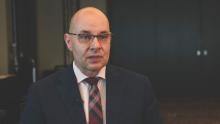TORONTO – If you don’t think clinicians should be worried about the current state of cardiovascular disease (CVD) prevention, consider the arresting data from the 2011 World Health Organization Global Atlas on CVD Prevention and Control.
The atlas showed that CVD accounts for 31% of deaths worldwide: 17.5 million deaths in 2012, projected to increase to 23.3 million deaths in 2030.
At the same time, the American Heart Association projects that by 2030, more than 40% of the U.S. population will have some form of CVD, with total direct costs projected to increase from $273 billion to $818 billion – and real indirect costs because of lost productivity will increase from $172 billion to $276 billion.
“We are not preventing CVD, and the worldwide prevalence of risk factors predicts a grim future,” Dr. Brian W. McCrindle, a staff cardiologist at the Hospital for Sick Children, Toronto, said at the International Society on Thrombosis and Haemostasis congress.
“One of the biggest problems is that we don’t give health and we don’t give prevention their fair due,” Dr. McCrindle continued. “We spend proportionately more health care dollars on providing care for acute and chronic illnesses, much of which are preventable. Our expenditures are growing, leaving little for prevention, and even less for children.”
According to Dr. McCrindle, today’s clinicians miss the mark on preventing CVD “because we focus our efforts on tertiary prevention – the treatment of existing symptomatic disease in order to ameliorate its effects, or treatment to delay or prevent progression; or on secondary prevention – the early detection of the potential for development of a disease, or the prevention of events in those with asymptomatic disease.
“We do make some effort regarding primary prevention – the reduction of risk factors before the occurrence of disease, but tend to delay these efforts until much later in adulthood,” he noted. “We do very little regarding primordial prevention – the prevention of risk factors from developing.”
Dr. McCrindle noted that atherosclerosis has been shown to begin in youth, and that obesity and other cardiovascular risk factors in children track into adulthood. “These findings are of concern regarding current prevention strategies,” he said.
“However, there are some important evidence gaps that need to be addressed before embarking on screening and intervention strategies in youth,” Dr. McCrindle cautioned. “Unfortunately, direct evidence does not exist to assert that risk factors measured in childhood are related to clinical events in adults, although long-term follow-up of existing cohorts may provide that.
“We may never have direct evidence that detection and management of risk factors in children reduce CVD events in adults, since a 50- to 60-year-long randomized trial can never be done,” Dr. McCrindle noted. “However, a chain of indirect evidence can be established.”
Key to current efforts, he continued, are the use of noninvasive ways to measure subclinical atherosclerosis, including ultrasound to assess endothelial function, arterial stiffness and intima-media thickness, and ultrafast computed tomography to detect coronary artery calcium. “These have been important predictors of events in adults, and are increasingly used in pediatric studies,” he said.
While he characterized the current health care landscape as being “at odds with the current reality facing today’s youth,” Dr. McCrindle suggested several ways that attendees can improve the CVD outlook in children, starting with being a role model for a healthy lifestyle. “We need to practice what we preach,” he said.
He also encouraged clinicians to implement existing pediatric guidelines on CVD health, assess and intervene on risk factors in children, and become more effective counselors.
“Instead of telling children what to do, we need to use techniques such as motivational interviewing to guide our young patients in discovering what they want to achieve,” Dr. McCrindle said. “We need to let kids set their own agenda and respect their autonomy. We also need to focus on ideal health across the lifespan, particularly on preventing risk factors and behaviors.”
Dr. McCrindle had no disclosures.
dbrunk@frontlinemedcom.com


